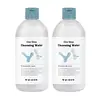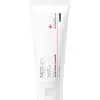What's inside
What's inside
 Key Ingredients
Key Ingredients

 Benefits
Benefits

 Concerns
Concerns

No concerns
 Ingredients Side-by-side
Ingredients Side-by-side

Water
Skin ConditioningPEG-6 Caprylic/Capric Glycerides
EmulsifyingDipropylene Glycol
HumectantButylene Glycol
HumectantCamellia Sinensis Leaf Water
MaskingPhenoxyethanol
PreservativeSodium Citrate
BufferingEthylhexylglycerin
Skin Conditioning1,2-Hexanediol
Skin ConditioningCamellia Sinensis Leaf Extract
AntimicrobialGlycyrrhiza Glabra Root Extract
BleachingAgrimonia Eupatoria Extract
AstringentDisodium EDTA
Citric Acid
BufferingPerilla Frutescens Leaf Extract
MaskingYucca Schidigera Root Extract
Skin ConditioningSapindus Mukorossi Fruit Extract
Skin ConditioningCucumis Sativus Fruit Extract
EmollientQuillaja Saponaria Bark Extract
CleansingSaponaria Officinalis Extract
Skin ConditioningBifida Ferment Lysate
Skin ConditioningLactobacillus Ferment Lysate
Skin ConditioningLactococcus Ferment Lysate
Skin ConditioningWater, PEG-6 Caprylic/Capric Glycerides, Dipropylene Glycol, Butylene Glycol, Camellia Sinensis Leaf Water, Phenoxyethanol, Sodium Citrate, Ethylhexylglycerin, 1,2-Hexanediol, Camellia Sinensis Leaf Extract, Glycyrrhiza Glabra Root Extract, Agrimonia Eupatoria Extract, Disodium EDTA, Citric Acid, Perilla Frutescens Leaf Extract, Yucca Schidigera Root Extract, Sapindus Mukorossi Fruit Extract, Cucumis Sativus Fruit Extract, Quillaja Saponaria Bark Extract, Saponaria Officinalis Extract, Bifida Ferment Lysate, Lactobacillus Ferment Lysate, Lactococcus Ferment Lysate
Water
Skin ConditioningLauryl Hydroxysultaine
CleansingSodium Chloride
MaskingPotassium Cocoyl Glycinate
Acrylates Copolymer
Disodium Cocoamphodiacetate
CleansingSodium Methyl Cocoyl Taurate
CleansingPotassium Cocoate
EmulsifyingSalicylic Acid
MaskingSodium Benzoate
MaskingMelaleuca Alternifolia Leaf Oil
AntioxidantHexylene Glycol
EmulsifyingDisodium EDTA
Citric Acid
BufferingGuaiazulene
AntimicrobialGluconolactone
Skin ConditioningCalamine
AbsorbentPanthenol
Skin ConditioningCapryloyl Salicylic Acid
ExfoliatingGlycyrrhiza Glabra Root Extract
BleachingGlycolic Acid
BufferingButylene Glycol
Humectant1,2-Hexanediol
Skin ConditioningCamellia Sinensis Leaf Extract
AntimicrobialCentella Asiatica Extract
CleansingMadecassoside
AntioxidantMelaleuca Alternifolia Leaf Extract
PerfumingWater, Lauryl Hydroxysultaine, Sodium Chloride, Potassium Cocoyl Glycinate, Acrylates Copolymer, Disodium Cocoamphodiacetate, Sodium Methyl Cocoyl Taurate, Potassium Cocoate, Salicylic Acid, Sodium Benzoate, Melaleuca Alternifolia Leaf Oil, Hexylene Glycol, Disodium EDTA, Citric Acid, Guaiazulene, Gluconolactone, Calamine, Panthenol, Capryloyl Salicylic Acid, Glycyrrhiza Glabra Root Extract, Glycolic Acid, Butylene Glycol, 1,2-Hexanediol, Camellia Sinensis Leaf Extract, Centella Asiatica Extract, Madecassoside, Melaleuca Alternifolia Leaf Extract
Ingredients Explained
These ingredients are found in both products.
Ingredients higher up in an ingredient list are typically present in a larger amount.
1,2-Hexanediol is a synthetic liquid and another multi-functional powerhouse.
It is a:
- Humectant, drawing moisture into the skin
- Emollient, helping to soften skin
- Solvent, dispersing and stabilizing formulas
- Preservative booster, enhancing the antimicrobial activity of other preservatives
Butylene Glycol (or BG) is used within cosmetic products for a few different reasons:
Overall, Butylene Glycol is a safe and well-rounded ingredient that works well with other ingredients.
Though this ingredient works well with most skin types, some people with sensitive skin may experience a reaction such as allergic rashes, closed comedones, or itchiness.
Learn more about Butylene GlycolCamellia Sinensis Leaf Extract is derived from the leaves of the tea plant. Black tea, green tea, and oolong tea are all harvested from this plant.
This ingredient has many skin benefits:
This ingredient contains polyphenols, a strong antioxidant. Antioxidants help fight off molecules that damage skin cells.
On top of that, the antioxidants in green tea neutralize free-radicals from the sun. This gives the skin some extra UV protection, but should not replace sunscreen.
Many components of tea have anti-inflammatory properties.
Polyphenols and L-theanine help soothe the skin and reduce irritation. The caffeine in Camellia Sinensis Leaf Extract helps calm inflamed blood vessels.
Other compounds found in tea include: Vitamin Bs, linoleic acid, magnesium, calcium, iron, and zinc.
Research has shown both drinking Camellia Sinensis Leaf Tea and applying it to the skin can help boost skin elasticity and hydration. Studies also show using tea extract may reduce sebum, or oil, production.
Learn more about Camellia Sinensis Leaf ExtractCitric Acid is an alpha hydroxy acid (AHA) naturally found in citrus fruits like oranges, lemons, and limes.
Like other AHAs, citric acid can exfoliate skin by breaking down the bonds that hold dead skin cells together. This helps reveal smoother and brighter skin underneath.
However, this exfoliating effect only happens at high concentrations (20%) which can be hard to find in cosmetic products.
Due to this, citric acid is usually included in small amounts as a pH adjuster. This helps keep products slightly more acidic and compatible with skin's natural pH.
In skincare formulas, citric acid can:
While it can provide some skin benefits, research shows lactic acid and glycolic acid are generally more effective and less irritating exfoliants.
Most citric acid used in skincare today is made by fermenting sugars (usually from molasses). This synthetic version is identical to the natural citrus form but easier to stabilize and use in formulations.
Read more about some other popular AHA's here:
Learn more about Citric AcidDisodium EDTA plays a role in making products more stable by aiding other preservatives.
It is a chelating agent, meaning it neutralizes metal ions that may be found in a product.
Disodium EDTA is a salt of edetic acid and is found to be safe in cosmetic ingredients.
Learn more about Disodium EDTAGlycyrrhiza Glabra Root Extract is an extract of the roots of Licorice. It has been found to have several benefits such as skin hydrating, conditioning, and soothing.
One component, glabridin, has extra potent antioxidant and soothing properties. It has also been found to block pigmentation from UVB rays in guinea pigs.
Licorice Root also contains a flavonoid. Flavonoids are a natural substance from in plants. Flavonoids also have antioxidant properties.
Another component, glycyrrhizin, has been found to have anti-inflammatory and antimicrobial benefits. This may make licorice root extract effective at treating acne. However, more research is needed to support this.
Liquiritin is one of the flavone compounds found in licorice. It has been found to help lighten skin by preventing tyrosinase from reacting with tyrosine. When the two react, protein is converted to melanin. Melanin is the substance in your body that gives your features pigmentation.
Learn more about Glycyrrhiza Glabra Root ExtractWater. It's the most common cosmetic ingredient of all. You'll usually see it at the top of ingredient lists, meaning that it makes up the largest part of the product.
So why is it so popular? Water most often acts as a solvent - this means that it helps dissolve other ingredients into the formulation.
You'll also recognize water as that liquid we all need to stay alive. If you see this, drink a glass of water. Stay hydrated!
Learn more about Water